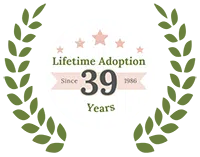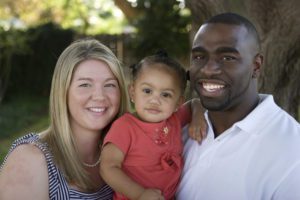Transracial Adoption (5 Ways to Honor Your Adopted Child’s Culture and Heritage)
Even though it is becoming more common, prospective adoptive parents are sure to have many questions about their transracial or biracial adoption. Whether the adopted child comes from a different subculture or an entirely different country, there will be some issues to address. 
Currently, a wide range of research supports the conclusion that children adopted across-race adjust equally as well as children adopted within-race. Children are capable of developing a solid sense of identity and family, regardless of race. The adopted child’s adjustment and self-esteem are more heavily influenced by parental warmth, positive parent-child communication, and positive ethnic experiences rather than the race of the adopted parents. Still need a little help? Here are 5 ways to promote healthy growth and maturity in a transracial adoption.
1. Educate Yourself.
Learn as much as you can about your child’s heritage. Check out books from the library and scour the internet for information. Read books and articles written by authors from your child’s culture. Make friends within your child’s cultural community. Ask them questions about traditions, celebrations, language and native dishes. Attend their church services or their events at community centers. As a family, decide how you can integrate aspects of your child’s heritage into your day-to-day life.
2. Plan how you will foster a positive cultural identity.
Current best practices encourage adoptive parents to talk with their children about adoption in positive, age-appropriate ways from day one. Discussing your child’s race and culture can be a natural part of these ongoing conversations.
Research shows that fostering ethnic pride contributes to healthy psychological adjustment in transracial adopted children. This leads to higher self-esteem and self-image. There are many ways that adoptive parents can discuss and celebrate the cultures of their transracial adopted children. Introducing books, music, art, and celebrations from the child’s culture is a good start.
Diana, a Caucasian adoptive parent who pursued an international adoption from China, recommends following your child’s lead. She waited until her son started to express interest in his culture. When her son turned eight, he began talking about visiting China and learning Mandarin. Diana supports her son’s interest and is planning a trip to his birthplace.
Celebrating cultural differences can also become a bonding experience between transracial adoptees and their adoptive parents. Kelly, a Caucasian adoptive parent, values the bonding time she spends with her biracial adopted daughter when caring for her hair. As her daughter got older, Kelly needed to educate herself on caring for African American hair. She sought help from books like Chocolate Hair Vanilla Care, YouTube videos, and assistance from her African American friends. Kelly lets her daughter choose her hairstyles and always reinforces how beautiful she looks. This routine has helped Kelly and her daughter grow closer together as they build a positive cultural image.
3. Recognize your child as an individual.
Race, gender, and adoptee are all part of your transracial or biracial adopted child’s identity, but each child is an individual. Your child’s experience as a transracial or biracial adoptee may not match the experience of all other adoptees from his culture.
Adoptive parents should communicate openly and often with their children to support healthy adjustment and positive self-identification. Be open to outside resources and counseling if those options suit your child’s individual needs.
Families with an open adoption plan may also have an opportunity to incorporate more of their transracial or biracial adopted child’s individual history into his life. Transracial adoptive parent, Rachel, has an open adoption plan, so she consulted the birth mother for advice on certain cultural celebrations. Her son’s birth mother’s parents, other children, so she shared a birthday tradition rooted in their Cajun heritage. By carrying on this tradition, Rachel is able to honor her son’s ethnic culture as well as his individual birth culture.
4. Encourage discussions about race and racism.
Conversations about race and racism can be uncomfortable, but don’t avoid them.
One study involving African American adoptees found that the children had more positive ethnic identity and adjustment when their transracial adoptive parents continued conversations about race all the way through adolescence.
Studies also show that transracial and biracial adopted children from families who openly discuss discrimination and stereotypes benefit from a stronger sense of family and identity.
Invite these opportunities to support your growing child’s identity as well as your identity as a multicultural family. Some transracial and biracial adoptive parents may choose to initiate these conversations regularly. Another way to broach the topic is to respond to events that arise in your community or in the news. You and your transracial or biracial adopted child may have different interactions and perceptions in society. Encourage everyone in your family to share their feelings about issues surrounding race.
These on-going conversations work to strengthen your multicultural family and build a more open-minded, global society.
5. Become part of the larger cultural community.
While immersing your transracial adopted child in books, music, and artifacts from her culture is important, research suggests that it is not enough. The most significant impact on positive cultural identity and self-esteem is found when transracial and biracial adoptees build meaningful relationships with people from their cultural community. Do you live in a diverse area? Does your transracial adopted child have access to multicultural experiences? Hopefully, you already have friends and connections within your child’s culture. Consider how you will lay a path for your transracial adopted child to bond with those positive role models.
Research cultural groups in your area. Seek assistance from local churches or from community centers to learn how to get involved. You can also take advantage of technology by joining a Facebook group dedicated to transracial adoption. The avenue does not matter as long as it leads to real, consistent connections to other people who share your child’s culture. It is important for your transracial or biracial adopted child to have meaningful relationships with both peers and role models in his cultural community.
Does your child regularly see people of different races in positions of authority? Weaving diversity into your everyday routine is another way to appreciate every culture. You can be mindful of diversity when making choices about your child’s doctors or coaches. Positive interactions with adults from different backgrounds will show your child that character, perseverance, and kindness cross racial lines.
As your transracial or biracial child grows older, she may take an interest in social issues involving her culture. This presents another opportunity to form relationships within the cultural community and support your child’s developing identity.
JaeRan Kim, assistant professor at the University of Washington, and transracial adoptee encourages transracial adoptive parents to get involved in the larger issues that impact their children. Take your child’s lead, and show her that the issues that are important to her are the issues that are important to your entire family.
Transracial and biracial adoptive parents can best prepare for their experience by educating themselves. Research and talk to other transracial and biracial adoptive parents as well as adult transracial and biracial adoptees.
Many adoptive parents who have successfully adopted transracially through Lifetime Adoption report positive experiences. They had initial concerns that the birth mother would be reluctant to match with adoptive parents of another race. However, they found that the birth mothers valued the adoptive parents’ faith, professions, and the connection they found with them over skin color. They have each found ways to promote positive cultural identity as they grow their multiracial families.
One adoptive mother, Diana, shares a story about her biological daughter’s response to being a conspicuous family. When her daughter had first heard the term, she asked Diana what it meant. Diana asked her daughter to think of ways their family may be seen as different. After some thought, her daughter responded that she and her transracial adopted brother had different looking toes. Skin color had not even entered her mind! This helped validate their decision to grow a multicultural family.
Lifetime’s transracial adoptive parents also report some uncomfortable responses from their communities, mostly in the form of stares and comments or questions from nosy strangers. They advise to always consider how you want your children to hear you respond before speaking out.
Adopting a child from another race will open your family up to unique new experiences. While these experiences may also bring challenges, you can meet them through preparation, love, and the faith that called you to adoption.
Get More Info Now
If you live outside of the United States, please click here.

Lifetime Adoption, Inc. is a Licensed Child Placing Agency in Arkansas. (License AR #00050809)
Copyright © | Lifetime Adoption






